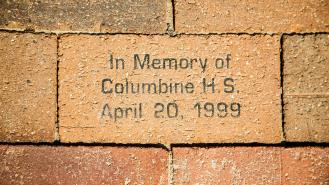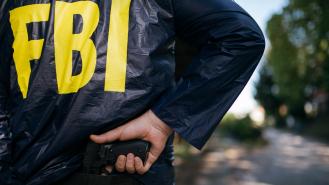
Why is April known as 'The Killing Season'?
'April is the cruellest month'
- TS Eliot
April begins with pranks. Rarely malicious by intent, the practical jokes we wake up to on April Fools’ Day are tricks nonetheless; hoaxes that feed off the gullibility of the most susceptible among us. Pranks may amuse the majority of folk, but they’re undeniably examples of humour at its most unkind. It’s certainly a mischievous way to kick off a month, at least.
Surely April, its capering trickster of a first day aside, has to be the calendar’s most joyous period? It’s spring’s first full month, after all. And spring is all about birth and rebirth; lambs being born and daffodils blooming. It’s about the return of warmer, nicer weather (April showers aside, of course).
It really could be the cruellest month, though. Here’s why...
Those of you unlucky enough to be born in the year's fourth month are 12% more likely to die of cardiovascular disease. Seems unfair, doesn't it? Well, quite. Take it up with Eva Schernhammer, Professor of Epidemiology at Harvard Medical School.
Here’s how Schernhammer summarises her finding on the subject: 'Compared with those people born in November, we observed higher cardiovascular mortality among those born from March to July, peaking in April, and the lowest among those born in December.'
The beginning of killing season?
The beginning of April also happens to coincide with the introduction of Daylight Savings Time. That means we start the month with an hour less of sleep and the days seeming longer to us. The sun sits in the sky longer, meaning we can work longer hours, pay attention more and sleep less. Less sleep means more fatigue, moodiness, forgetfulness, feelings of depression and a whole heap of physical ailments and other quite serious health issues.
It gets more nefarious, though. This is where true crime buffs ears prick up.
In some circles, April is known as the start of a wave of disturbing events. Many criminologists and terrorism experts recognise a seasonality of violence, a cluster of attacks that begin in April. A ‘killing season’.
Heidi Beirich, a domestic terrorism expert at the Southern Poverty Law Center explains it like this: 'It's a question we talk about all the time. It's a really strange phenomenon. We sometimes refer to April as the beginning of killing season. We know from looking at the data that there tends to be a season in which a lot of domestic terrorism attacks occur, and that season runs from early April into the early fall.'
Beirich’s research shows that 78.9% of far-right attacks in the past two decades occurred between April and September. That’s just a third of the year seeing four-fifths of all lethal domestic terrorist attacks.
For this look at the idea of a ‘killing season’, we’ll focus on domestic terror events from modern American history. The kind of extremist attacks that make global news and shock everyone who hears about them and sees footage of them on television.
Here are just some of the better-known terror attacks that Aprils have hosted in the US in recent years:
The Waco Siege Firefight and Blaze (19th April 1993)
86 people died during the siege at Waco that pitted cult leader David Koresh’s Branch Davidians against the US federal government. 80 of those died during the final assault and burning down of the Mount Carmel compound.
The Oklahoma Bombing (19th April 1995)
Timothy McVeigh and Terry Nichols parked a truck bomb in front of a federal building in downtown Oklahoma City. When it exploded it killed 168 people.
The Columbine School Massacre (20th April 1999)
12 students and a teacher died - and a further 24 were injured - when Eric Harris and Dylan Klebold opened fire in a high school in Colorado.
The Boston Marathon Bombing (15th April 2013)
3 died and a further 264 were injured when two men set off pressure cooker bombs at the finish line of the famous long-distance race.
The Overland Park Jewish Community Center shooting (13th April 2014)
3 people were shot dead in an antisemitic attack in a Jewish community in Kansas.
The Virginia Tech Mass Shooting (16th April 2007)
South Korea-born student Seung-Hui Cho killed 32 people and wounded 17 others with a pair of semi-automatic pistols before turning the gun on himself. It was, and remains, the deadliest school shooting in the history of the US.
The Franklin Regional High School stabbing (9th April 2014)
16 year-old student Alex Hribal used two 8" kitchen knives to stab and slash at 20 students and a security guard at his high school in Murrysville, Pennsylvania
Those are just domestic terror events in America in the past few decades. If we were to add high-profile assassinations in the country in its relatively short history we could throw the murders of the likes of Abraham Lincoln and Martin Luther King into the mix.
So what’s behind the phenomenon?
The relationship between violence and weather
April sees an upturn in weather and a rise in temperatures. As the weather outside becomes warmer, everything begins to heat up. When things come to the boil and simmer over, that generally means violence. Humanity has long identified a link between heat and our propensity for brutality. The science backs this up.
When the weather heats up, the human body changes. We sweat more, our heart rate increases, our blood circulation is stimulated and our metabolism quickens. All of which is linked to the ingrained fight-or-flight response inside us all. Hotter weather also sees an increase in the production of testosterone. Which makes us all a little more prone to pick fight over flight.
There's also research which indicates that warmer weather encourages people to interpret neutral signals from others as explicit and intentional signs of hostility. Those same studies also suggest that we become far less likely to condemn violence by others. Overheated people simply have trouble thinking straight.
Let’s not dismiss the seemingly obvious, though. For terror attacks to be effective, those responsible for them want people on the streets. The more people, the more potential victims. It makes sense to plan in the winter and strike when the weather first starts to improve.
'You have these people coming out of hibernation from the winter with all their anger peaked and ready to go," says Adam Lankford, a University of Alabama professor who researches mass shootings and suicide bombings. He theorises that rage can build up as potentially violent ideologues watch others out having fun together socially. "That highlights the discrepancies between those who are socially healthy and those who aren't.'
Patriots Day, Hitler’s birthday and other anniversaries
One reason why April tends to see an ‘awakening’ in this kind of violence is that there are a couple of quite notable dates sprinkled throughout the month. Anniversaries such as Adolf Hitler’s birthday have resonance with a lot of right-wing and anti-Semitic groups for rather obvious reasons.
Hitler's birthday falls on April the 20th, the very same day that Harris and Klebold carried out the now infamous Columbine shooting. It was no coincidence.
'April is a month that looms large in the calendar of many extremists in the United States, from racists and anti-Semites to anti-government groups," says an Anti-Defamation League spokesperson. "Some groups organize events to commemorate these April dates. Moreover, there is always a certain threat that one or more extremists may choose to respond to these anniversaries with some sort of violent act.'
It’s also no accident that Tim McVeigh blew up the Alfred P. Murrah Federal Building in Oklahoma City two years to the day that the feds stormed the Branch Davidians’ compound in Waco, Texas. The bombing was a direct message about how the federal government handled the siege.
It’s widely believed that the Boston Marathon bombers, Dzhokhar and Tamerlan Tsarnaev, specifically chose Patriots Day - a Massachusetts state holiday commemorating the first battles of the American Revolutionary War - for their attack. As if to rub salt into the wounds they’d created.
Confirmation bias?
Enough academics have spoken out on April seeing a spike in ideological violence to give credence to the idea. But whether or not the month itself is some sort of mystical harbinger of death is, alas, rather unlikely. There could even be a little confirmation bias at play here. We listed some pretty significant and noteworthy acts of terror and violence above. When drawing up that list however, we had to ignore countless atrocities that didn’t occur in April. Why? Well, they don’t fit the narrative. When any theory is put forward that appeals to the human mind, we inherently then seek out information that establishes the likelihood that it’s correct. And, so it would follow, we tend to pay far less attention to data and information which serves to disprove the concept. Do people that argue that a ‘killing season’ exists and starts in April just cherry-pick their events and allow confirmation bias to take over? There’s certainly a chance.
The Truth
As ever in life, it’s difficult to know what the ‘real’ truth is. Like a lot of things, the phenomenon of a ‘killing season’ is quite hard to prove. It’s also hard to disprove. There’s evidence for its existence on both sides. Context is key here, though. It only appears to be certain types of violence that seem to ramp up as of April, not all forms. So at least that’s reassuring for most of us. So was TS Eliot right in his assertion that April is the cruellest month? Well, it’s tricky to say. But there’s certainly something about those 30 days.









